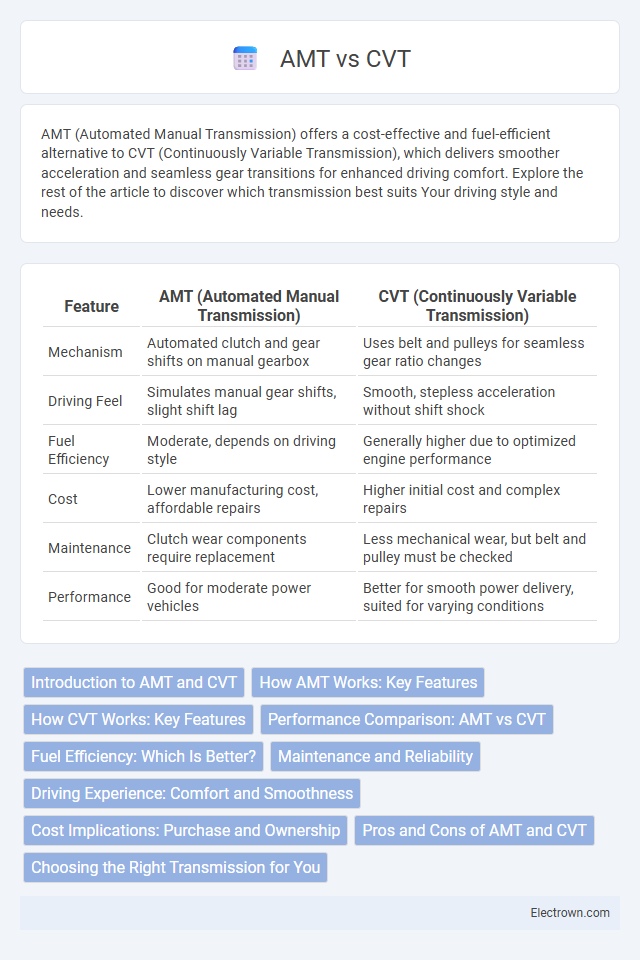AMT (Automated Manual Transmission) offers a cost-effective and fuel-efficient alternative to CVT (Continuously Variable Transmission), which delivers smoother acceleration and seamless gear transitions for enhanced driving comfort. Explore the rest of the article to discover which transmission best suits Your driving style and needs.
Table of Comparison
| Feature | AMT (Automated Manual Transmission) | CVT (Continuously Variable Transmission) |
|---|---|---|
| Mechanism | Automated clutch and gear shifts on manual gearbox | Uses belt and pulleys for seamless gear ratio changes |
| Driving Feel | Simulates manual gear shifts, slight shift lag | Smooth, stepless acceleration without shift shock |
| Fuel Efficiency | Moderate, depends on driving style | Generally higher due to optimized engine performance |
| Cost | Lower manufacturing cost, affordable repairs | Higher initial cost and complex repairs |
| Maintenance | Clutch wear components require replacement | Less mechanical wear, but belt and pulley must be checked |
| Performance | Good for moderate power vehicles | Better for smooth power delivery, suited for varying conditions |
Introduction to AMT and CVT
Automated Manual Transmission (AMT) combines a traditional manual gearbox with automated clutch operation, offering drivers the convenience of an automatic without sacrificing fuel efficiency. Continuously Variable Transmission (CVT) uses a system of pulleys and belts to provide seamless gear ratios, enhancing smooth acceleration and improving fuel economy. Both transmissions aim to optimize driving comfort and efficiency, but they differ fundamentally in mechanism and performance characteristics.
How AMT Works: Key Features
AMT (Automated Manual Transmission) operates by using an electro-hydraulic system to automate clutch engagement and gear shifts, combining manual transmission mechanics with computer-controlled automation. Key features include precise gear changes without a clutch pedal, improved fuel efficiency compared to traditional automatics, and reduced driver effort while maintaining the direct power flow and performance characteristics of a manual gearbox. Your driving experience benefits from smoother shifts and better control over gear selection, especially in urban and stop-and-go traffic conditions.
How CVT Works: Key Features
CVT (Continuously Variable Transmission) operates using a system of pulleys and a flexible belt, allowing seamless ratio changes without fixed gear steps, which optimizes engine performance and fuel efficiency. Its key features include smooth acceleration, improved fuel economy, and reduced mechanical complexity compared to traditional automatics or AMTs (Automated Manual Transmissions). Your driving experience benefits from CVT's ability to maintain the engine in its ideal RPM range for varying speed conditions.
Performance Comparison: AMT vs CVT
AMT (Automated Manual Transmission) delivers a more direct and mechanical driving experience with quicker gear shifts, making it ideal for performance enthusiasts seeking control and responsiveness. CVT (Continuously Variable Transmission) offers smoother acceleration and improved fuel efficiency by seamlessly adjusting gear ratios without discrete shifts, enhancing comfort and efficiency during daily driving. Your choice between AMT and CVT depends on whether you prioritize sporty performance with crisp gear changes or refined, fuel-saving operation.
Fuel Efficiency: Which Is Better?
AMT (Automated Manual Transmission) generally offers better fuel efficiency than traditional automatic transmissions due to its direct mechanical connection and reduced power loss. CVT (Continuously Variable Transmission) excels in optimizing engine performance by providing seamless gear ratios, often resulting in superior fuel economy during varying driving conditions. In most practical scenarios, CVT tends to deliver better overall fuel efficiency, especially in city driving and stop-and-go traffic.
Maintenance and Reliability
Automated Manual Transmissions (AMTs) generally require less frequent maintenance but may experience higher wear on clutch components due to the mechanical nature of gear shifts. Continuously Variable Transmissions (CVTs) rely heavily on belt or chain systems, which necessitate periodic inspection and potential replacement to maintain reliability. Both transmission types offer distinct maintenance challenges, with CVTs often praised for smoother operation but requiring more specialized servicing.
Driving Experience: Comfort and Smoothness
AMT (Automated Manual Transmission) offers a more affordable solution with quicker gear shifts but may cause slight jerks during acceleration, affecting driving comfort. CVT (Continuously Variable Transmission) provides a seamless and smooth driving experience by eliminating gear shifts, resulting in consistent power delivery and enhanced ride comfort. Your choice between AMT and CVT can significantly impact driving smoothness, with CVT being preferred for a refined and comfortable ride.
Cost Implications: Purchase and Ownership
Automated Manual Transmissions (AMT) generally offer lower initial purchase costs compared to Continuously Variable Transmissions (CVT), making them a budget-friendly choice for many buyers. In terms of ownership, AMTs tend to have simpler mechanical components, resulting in potentially lower maintenance and repair expenses over time. CVTs, while smoother and more fuel-efficient, often involve higher repair costs due to the complexity of their belt and pulley systems.
Pros and Cons of AMT and CVT
Automated Manual Transmission (AMT) offers the benefit of fuel efficiency and lower maintenance costs but may suffer from slower gear shifts and less smooth driving compared to Continuous Variable Transmission (CVT). CVT provides seamless acceleration and improved driving comfort due to its infinite gear ratios but can be more expensive to repair and sometimes less engaging for the driver. Your choice depends on whether you prioritize cost-effectiveness with AMT or smooth performance with CVT.
Choosing the Right Transmission for You
Choosing the right transmission depends on your driving preferences and vehicle needs, with AMT (Automated Manual Transmission) offering a budget-friendly option that combines manual gear shifting with automation for efficiency and simplicity. CVT (Continuously Variable Transmission) excels in providing smooth, seamless acceleration and improved fuel economy by eliminating fixed gear ratios. Your choice should consider factors like fuel efficiency, driving comfort, and maintenance costs to match your lifestyle optimally.
AMT vs CVT Infographic

 electrown.com
electrown.com